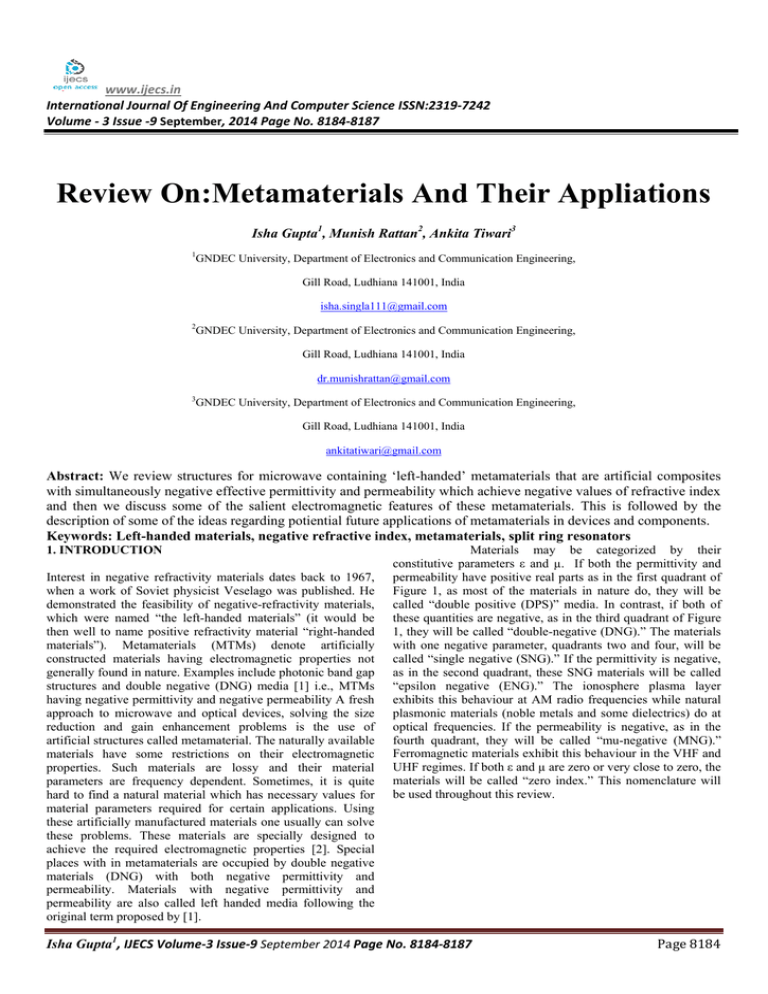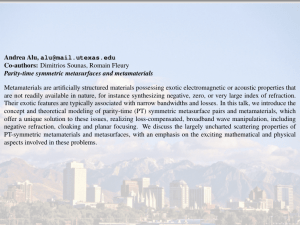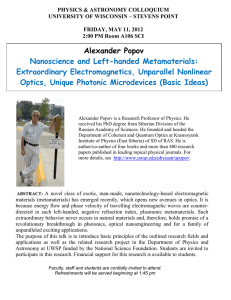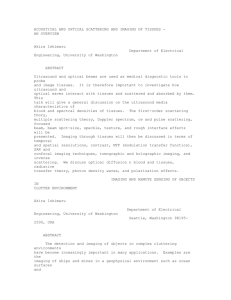International Journal Of Engineering And Computer Science ISSN:2319-7242
advertisement

www.ijecs.in International Journal Of Engineering And Computer Science ISSN:2319-7242 Volume - 3 Issue -9 September, 2014 Page No. 8184-8187 Review On:Metamaterials And Their Appliations Isha Gupta1, Munish Rattan2, Ankita Tiwari3 1 GNDEC University, Department of Electronics and Communication Engineering, Gill Road, Ludhiana 141001, India isha.singla111@gmail.com 2 GNDEC University, Department of Electronics and Communication Engineering, Gill Road, Ludhiana 141001, India dr.munishrattan@gmail.com 3 GNDEC University, Department of Electronics and Communication Engineering, Gill Road, Ludhiana 141001, India ankitatiwari@gmail.com Abstract: We review structures for microwave containing ‘left-handed’ metamaterials that are artificial composites with simultaneously negative effective permittivity and permeability which achieve negative values of refractive index and then we discuss some of the salient electromagnetic features of these metamaterials. This is followed by the description of some of the ideas regarding potiential future applications of metamaterials in devices and components. Keywords: Left-handed materials, negative refractive index, metamaterials, split ring resonators 1. INTRODUCTION Interest in negative refractivity materials dates back to 1967, when a work of Soviet physicist Veselago was published. He demonstrated the feasibility of negative-refractivity materials, which were named “the left-handed materials” (it would be then well to name positive refractivity material “right-handed materials”). Metamaterials (MTMs) denote artificially constructed materials having electromagnetic properties not generally found in nature. Examples include photonic band gap structures and double negative (DNG) media [1] i.e., MTMs having negative permittivity and negative permeability A fresh approach to microwave and optical devices, solving the size reduction and gain enhancement problems is the use of artificial structures called metamaterial. The naturally available materials have some restrictions on their electromagnetic properties. Such materials are lossy and their material parameters are frequency dependent. Sometimes, it is quite hard to find a natural material which has necessary values for material parameters required for certain applications. Using these artificially manufactured materials one usually can solve these problems. These materials are specially designed to achieve the required electromagnetic properties [2]. Special places with in metamaterials are occupied by double negative materials (DNG) with both negative permittivity and permeability. Materials with negative permittivity and permeability are also called left handed media following the original term proposed by [1]. Materials may be categorized by their constitutive parameters ε and µ. If both the permittivity and permeability have positive real parts as in the first quadrant of Figure 1, as most of the materials in nature do, they will be called “double positive (DPS)” media. In contrast, if both of these quantities are negative, as in the third quadrant of Figure 1, they will be called “double-negative (DNG).” The materials with one negative parameter, quadrants two and four, will be called “single negative (SNG).” If the permittivity is negative, as in the second quadrant, these SNG materials will be called “epsilon negative (ENG).” The ionosphere plasma layer exhibits this behaviour at AM radio frequencies while natural plasmonic materials (noble metals and some dielectrics) do at optical frequencies. If the permeability is negative, as in the fourth quadrant, they will be called “mu-negative (MNG).” Ferromagnetic materials exhibit this behaviour in the VHF and UHF regimes. If both ε and µ are zero or very close to zero, the materials will be called “zero index.” This nomenclature will be used throughout this review. Isha Gupta1, IJECS Volume-3 Issue-9 September 2014 Page No. 8184-8187 Page 8184 Figure: 1Classification of metamaterials by the real parts of their constitutive parameters, i.e., their permittivity and permeability. We note that the realization of SNG materials may be relatively easier than that of DNG materials. Therefore, many recent efforts have been aimed at exploring if SNG media can be used to achieve some of the applications originally proposed for DNG media. To achieve negative values of the constitutive parameters ε and μ, metamaterials must be dispersive, i.e., their permittivity and permeability must be frequency dependent, otherwise they would not be causal [3]. 2. BASIC PROPERTIES OF METAMATERIALS Veselago showed that the pattern of refraction and deflection of an electromagnetic wave when passing through the interface between two media-varies depending on whether the refractivities of both materials are of the same or opposite sign. If the refractivities of the materials are of the same sign, the wave incident on the interface on one side of the normal to it appears, after being refracted, on the other side of the normal. If the refractivities of the materials are of opposite sign, the incident and refracted waves are on the same side of the normal [4]. Another intriguing property of metamaterials is the specific dispersion of waves propagating in them. The equation of electromagnetic wave propagation in an isotropic medium has the form ( ) where k is the wavenumber; ω is the angular frequency of the wave; c is the velocity of light in vacuum; n2 = εμ is the refractive index squared; and ε and μ are, respectively, the permittivity and permeability of the medium. The term “dispersion” signifies the dependence of the wave oscillation frequency on the wavenumber or, in other words, on wavelength λ (k = 2π/λ) of the oscillatory process. From (1) we have The dispersion of an electromagnetic wave depends primarily on the refractive index. Left-handed media have a negative refractive index. Figure: 2 Schematic of negative refraction at the interface between a positive-index material and a negative-index material. Note in the negative-index material, the wave vector (k) and Poynting vector (S) are antiparallel; while in the positive-index material, they are parallel. Equation (1) was derived from the Maxwell theory. As shown in figure 2, the media in which both permittivity ε and permeability μ are positive, electric vector E, magnetic vector H, and propagation vector k of the electromagnetic field produce a so called right-handed system of vectors, have a negative refractive index ( ) ( ) (3) Such media are referred to as “right-handed media.” For media in which both ε and μ are negative, electric vector E, magnetic vector H, and propagation vector k produce a left-handed system of vectors. To characterize the propagation and dispersion of waves, it is necessary to give a definition of the phase and group velocities of a wave. For a plane harmonic wave, the phase velocity in the direction of the propagation vector is the velocity of the equi-phase surface, which can be expressed as follows: (4) Substituting expression (2) for ω into (4) yields the seemingly obvious relationship (5) from which it follows that the phase velocity of a wave in a metamaterial can be negative. The negativeness of the phase velocity means that, when a wave propagates, the phase advances from the detector to the source, whereas the energy is obviously transferred in the reverse direction. The group velocity characterizes the propagation velocity of a “group of waves” or, in other words, a more or less localize quasi-monochromatic wave (wave with a narrow spectrum). The group velocity is usually treated as the propagation velocity of the maximum of the amplitude envelope of a quasimonochromatic wave packet. In the ideal case, the group velocity is determined from the dispersion law, (6) If the dispersion properties of the medium are such that the wave packet propagates without significantly changing the shape of its envelope, the group velocity can be viewed as the transfer rate of the wave “energy” or the rate with which the wave packet transfers information bearing signals in accordance with the causality principle. As follows from the Isha Gupta1, IJECS Volume-3 Issue-9 September 2014 Page No. 8184-8187 Page 8185 relativity theory, the group velocity is always positive and is lower than, or equal to, the velocity of light in vacuum. In the dispersion free media, the group velocity coincides with the phase velocity. 3. NEGATIVE INDEX METAMATERIALS AND THEIR APPLICATIONS By overlapping two sets of meta-structures with εreff < 0 and μreff < 0 in the same frequency window, we expect to create metamaterials with a negative effective refractive index (i.e., neff < 0), which were first experimentally demonstrated by Smith and colleagues in the microwave domain [5]. Within several years, magnetic metamaterials, and consequently NIMs have been advanced from microwave frequencies to the visible region, by scaling down the structure size and taking prudent designs [6]. Negative permeability is the heart of NIMs. To achieve magnetic resonance at optical frequencies, however, it is shown that the size of SRRs has to be smaller than 100 nanometres, and the gap is less than 10 nanometres. Furthermore, the amplitude of the resonant permeability from SRRs decreases and ultimately ceases to reach a negative value in the visible region [7]. These challenges impelled researchers to seek alternative designs other than the combination of metallic wires and SRRs. The most successful NIMs so far are the fishnet structure [8] which consists of two layers of metal meshes separated by a dielectric spacer layer Figure 3. The paired stripes that are oriented parallel to the electric field provide negative εreff, while the other pairs of stripes parallel to the magnetic field offer negative μreff. Since the thickness of the spacing dielectric is easy to control, the simple design of the fishnet structure significantly eases the fabrication burden, compared to the conventional approach of combing SRRs and metallic wires. In addition, the EM waves are incident normal to the fishnet sample surface to produce the negative refractive index. This configuration is much easier than that for NIMs based on SRRs and wires, which require oblique incidence of EM waves to excite SRRs with out-of-plane magnetic fields for strong magnetic resonances. Figure: 3 Fishnet structure as NIMs in the visible region (yellow light) dependence on the resonant properties of the structure, produce a magnetic field that may either oppose or enhance the incident field, thus resulting in positive or negative effective μ. In other words, the operation of a SRR represents an over-screened, under-damped response of material to electromagnetic stimulation. For a circular double split ring resonator as shown in figure 4 (a) in vacuum and with a negligible thickness the following approximate expression is valid. =1 (7) Figure: 4 Planar geometries of negative permeability material unit cell based on the split ring resonator; a) circular structure; b) square structure The rapidly growing metamaterials research is driven by a number of potential applications of metamaterials. At the early stage of metamaterials research, besides magnetic resonance imaging, novel microwave circuits, and antennas at microwave region [9], perfect lens with imaging resolution beyond the iffraction limit is one of the most attractive devices [10]. In conventional optical systems, we cannot resolve two points separated less than λ/2n, where n is the refractive index of the ambient medium. This fundamental limitation exists because the information of the object’s fine features is carried by evanescent waves, which exponentially decay in space. All the information relevant to the subwavelength details of the object is lost, before reaching the imaging plane. However, a flat slab of NIM, proposed by Pendry, can work as a perfect lens to recover all the lost information. This remarkable property of perfect lens arises from the fact that the initially decayed evanescent waves are now amplified through the NIM slab. Meanwhile, the propagating waves are focused due to the negative refraction and reversed phase front. As a result, a NIM slab incredibly brings both propagating and evanescent waves to a perfect focus (Figure 5 (a) and (b)), without suffering the traditional constraint imposed by the diffraction limit. 3.1 Split Ring Resonator For decades, and starting in the early 1950s, different ring or ring-like structures with negative permeability were of interest as building blocks for artificial chiral materials in microwave. A double split ring resonator (SRR) is a highly conductive structure in which the capacitance between the two rings balances its inductance. A time-varying magnetic field applied perpendicular to the rings surface induces currents which, in Isha Gupta1, IJECS Volume-3 Issue-9 September 2014 Page No. 8184-8187 Page 8186 Figure: 5 (a) A flat NIM slab can focus all the light rays from a point source, arising from the negative refraction. (b) The NIM slab can also amplify evanescent waves, leading to perfect imaging at the image plane. 4. Conclusion “Photonic Band Gap from a Stack of Positive and Negative Index Materials,” Phys. Rev. Lett, Vol.90, pp. 46-52, 2003. [10] J. B. Pendry, “negative refraction makes a perfect lens,” Physical review letter, Vol. 85, No. 4, pp. 3966-3969, 2000. Without any doubt, metamaterials have become an extremely exciting research area. The unique electromagnetic properties provided by metamaterials attract considerable attention of researchers from multiple disciplines. In turn, this will spark the merging of knowledge and expertise across different areas, further driving the astounding advance of metamaterials research. Currently the focus is shifting from microwave applications to terahertz frequencies. The endeavour to create optical NRM metamaterials and applications will require a number of innovative techniques, including intensive use of micro and nanofabrication. The speed of the development of the NRM and the number of teams participating its research anticipates fruitful results and a bright future for the field. References [1] V. G. Veselago, “The electrodynamics of substances with simultaneously negative values of epsilon (ε) and mu (μ),” Sov. Phys. Uspekhi, Vol. 10, pp. 509-514, 1968. [2] J. B. Pendry, A. J. Holden, D. J. Robbins and W. J. Stewart, “ Low frequency plasmonics in thin wire structures,” J. Phys: Condens. Matter, Vol. 10, pp. 4785-4788, 1998 [3] D. R. Smith and N. Kroll, “Negative refractive index in left-handed materials,” Phys. Rev. Let, Vol. 85, pp. 2933–2936, 2000. [4] Ziolkowski, “Design, fabrication and testing of double negative metamaterials,” IEEE Trans.on Antennas and Propagation, Vol. 51, No. 7, pp. 1516-1529, 2003. [5] D. R. Smith, W. J. Padilla, D. C. Wier, S. C. N. Nasser and S. Schultz, “A composite medium with simultaneously negative permeability and permittivity,” Physical Review Letters, Vol. 84, No. 18, pp. 4184-4187, 2000. [6] D. R. Smith, W. J. Padilla, D. C. Wier, S. C. N. Nasser and S. Schultz, “A composite medium with simultaneously negative permeability and permittivity,” Phys. Rev. Lett, Vol. 84, No. 18, pp. 4184-4187. [7] M. W. McCall, A. Lakhtakia, and W. S. Weiglhofer, “The negative index of refraction in the metamaterials,” Eur. J. Phy, Vol. 23, pp. 353-359, 2002. [8] A. Lakhtakia and W. S. Weiglhofer, “Breif overview of recent developments on negative phase-velocity medium,” International Journal of Electronic and Communication, Vol. 56, No. 6, pp. 407-410, 2002. [9] J. Li, L. Zhou, C.T. Chan and P. Sheng, Isha Gupta1, IJECS Volume-3 Issue-9 September 2014 Page No. 8184-8187 Page 8187


